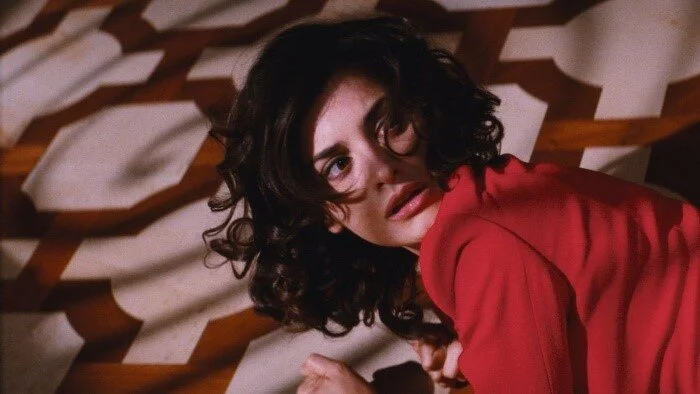Transatlantic Cinema Gems
Playing with Perception in Almodóvar’s Broken Embraces
Sybilla Hamilton
Column II
There is a feeling after watching an Almodóvar film of profound satisfaction that you perhaps don’t get from any other director. His plots are melodramatic, passionate, almost childish, yet he somehow manages to be extremely self-aware of his cinematography and the characters that he creates.
Broken Embraces is the most beautiful example of this, seeping further into your thoughts as time passes after you watch it. Like a deceiving, sweet, boozy cocktail, the harmless pleasure you initially experience in watching it turns into an intoxicating thought that lingers in your mind for days after, encouraging you to think about perception, creation, and imitation until the three blur together into a wonderful kaleidoscope of everything typically Almodóvar - in three words: women, drama, cinema. This melodrama follows a film-director-turned-scriptwriter (Lluís Homar) as he recounts his memories of a former lover (Penelope Cruz), who is caught in a loveless relationship with millionaire Ernesto Martel (José Lluis Gómez). Like many of Almodóvar’s films, we see themes of sexuality, relationships, and love intertwine with storms of passion, envy, lust, and revenge. However, what I loved about Broken Embraces were the references to sight that held these ideas together.
The film revolves around this photo which Almodóvar himself took of Lanzarote’s landscape. Upon looking closer, it shows a couple embracing. Source: https://thelongnwindingroad.wordpress.com/2010/05/08/el-ultimo-beso-con-un-abrazo-roto-the-singapore-grand-premiere-of-pedro-almodovars-los-abrazos-rotos-broken-embraces/
The film opens with a close-up of an eye, which we discover is that of a beautiful blonde who had agreed to read a newspaper for the blind protagonist, Harry Caine. We see the camera begin to slowly trace the physical features of the woman, in response to Caine’s innocuous yet subtly seductive question “What are you like?”. The use of camera as well as her description combines audible and visual imagery, and the superfluity of the audio allows the audience to recognise the power of sight. She tells him that Ernesto Martel has died – a fact seemingly unimportant but which drives the plot. He later searches the news online and we discover, along with the character, further details of the death, but only through a painfully robotic, voice-assisted search that is almost as comedic as it is frustrating to watch. Making a film about someone who is blind immediately calls into question what is seen and what is not seen; the camera becomes a character in itself through its possession of a medium and language – a stark contrast with the character’s absence of these.
Yet Almodóvar doesn’t just keep this dynamic within the wider film, but uses a film-within-a-film, and even a documentary about this film-within-a-film, blurring the lines between fiction and reality, truth and falsehood, what exists and what is absent. Even the clips we see of the film that the characters are shooting directly reference Almodóvar’s 1988 Women on the Verge of a Nervous Breakdown, a comedy-drama with the same themes, and whose protagonist famously sets a bed on fire with cigarettes and laces gazpacho with sleeping pills for revenge on an ex-lover.
A particularly aesthetic shot in Broken Embraces, vibrantly colourful as always… Here, Homar and Cruz stand where Almodóvar took the photo that partly inspired the film. Source: https://almostginger.com/films-set-in-spain/
In one of my favourite sequences of Broken Embraces, Lena tells her lover Ernesto that she is leaving him, both over a recording and in-person simultaneously. His shock is deliciously juxtaposed by the slick synchronisation of her dialogue, which is completely in time with the recording playing behind him. There is a strong sense of repulsion and passion in her words, and a coldness that permeates through to the viewer, owing to the flat, materialistic nature of the film recording. Again, Almodóvar brings into question this idea of truth and lies, blurring what is real and performed. Cruz’s character embodies this contradiction, shattering the meta-cinematic boundaries as she flits between characters. In a scene in her dressing room, before her character’s first film is shot, she poses for photos with various wigs, changing from Audrey Hepburn to Marilyn Monroe in the flash of the camera. She looks directly at the camera, but is it their camera, or ours? They become one and the same, destabilising the limits of cinema as both an art form and narrative medium. She is a ghost, an image immortalised on a screen, an actress who represents all actresses. Caine loses his eyesight and her along with it, restricting her existence to the object of others’ gaze.
Combine obsession, neo-noir, and some red for an explosive plot… Penelope Cruz as Lena. Source: https://www.salon.com/2009/11/19/broken_embraces/
Almodóvar plays with the cinematic art form and fills the film with his love for it. He combines beautifully aesthetic shots with a passionate plot, and yet stays fiercely aware of the art he is creating. He floods our senses through a carefully curated exhibition of emotions, displaying human behaviour both at its most powerful yet also most civilised. Due to the versatility of the camera, cinema is an art form unique in the way it plays with perception, of which Almodóvar is clearly a master.


